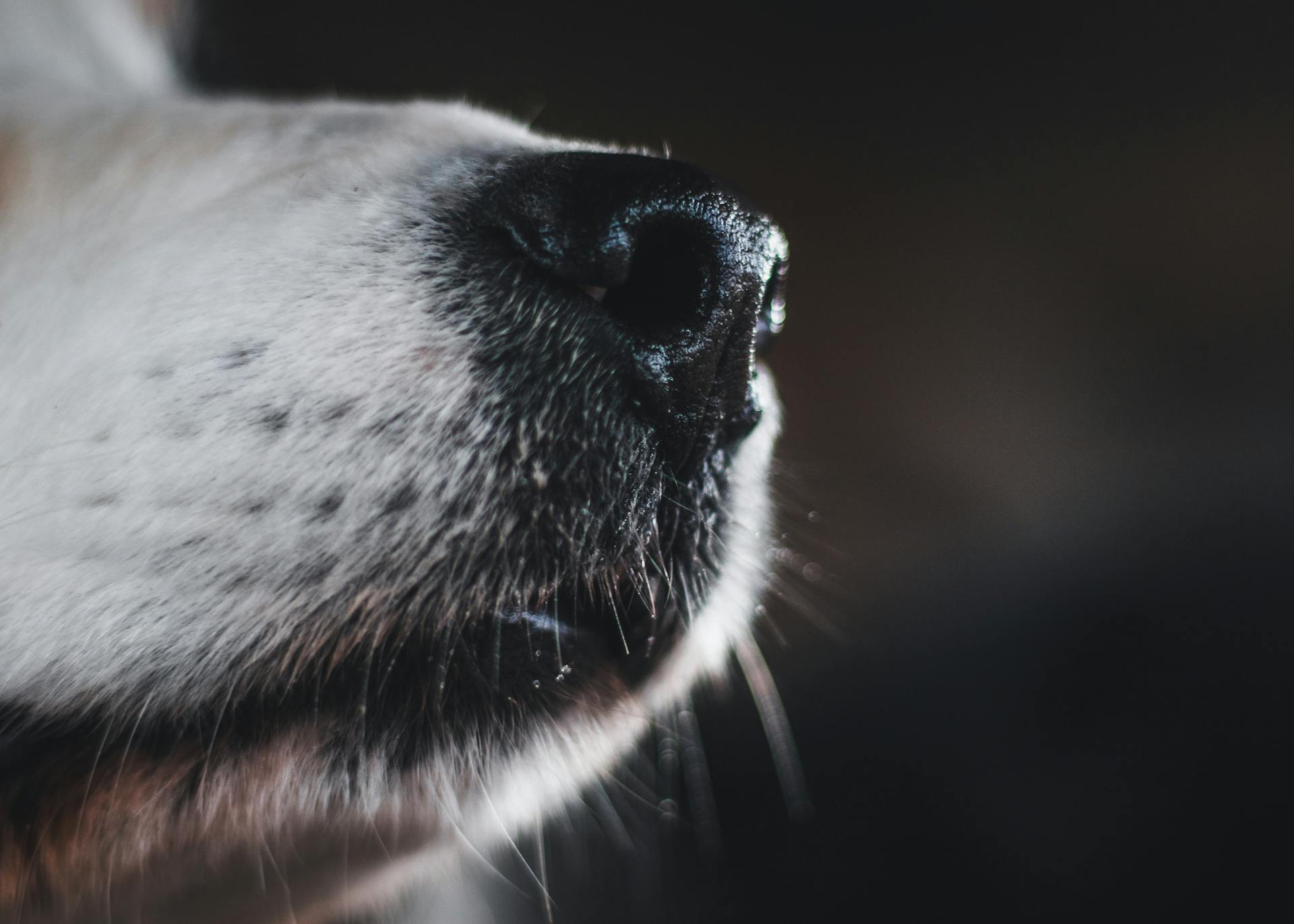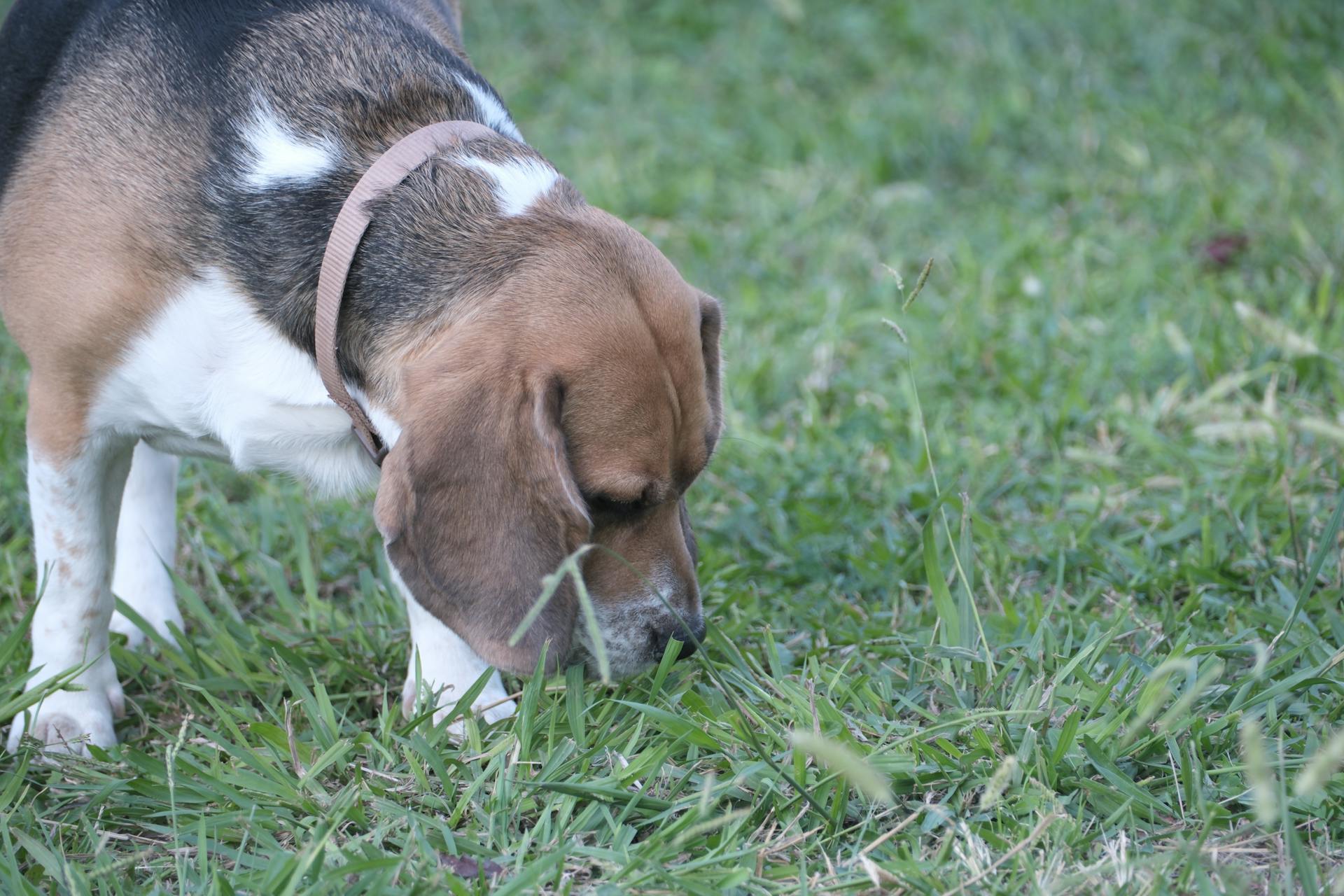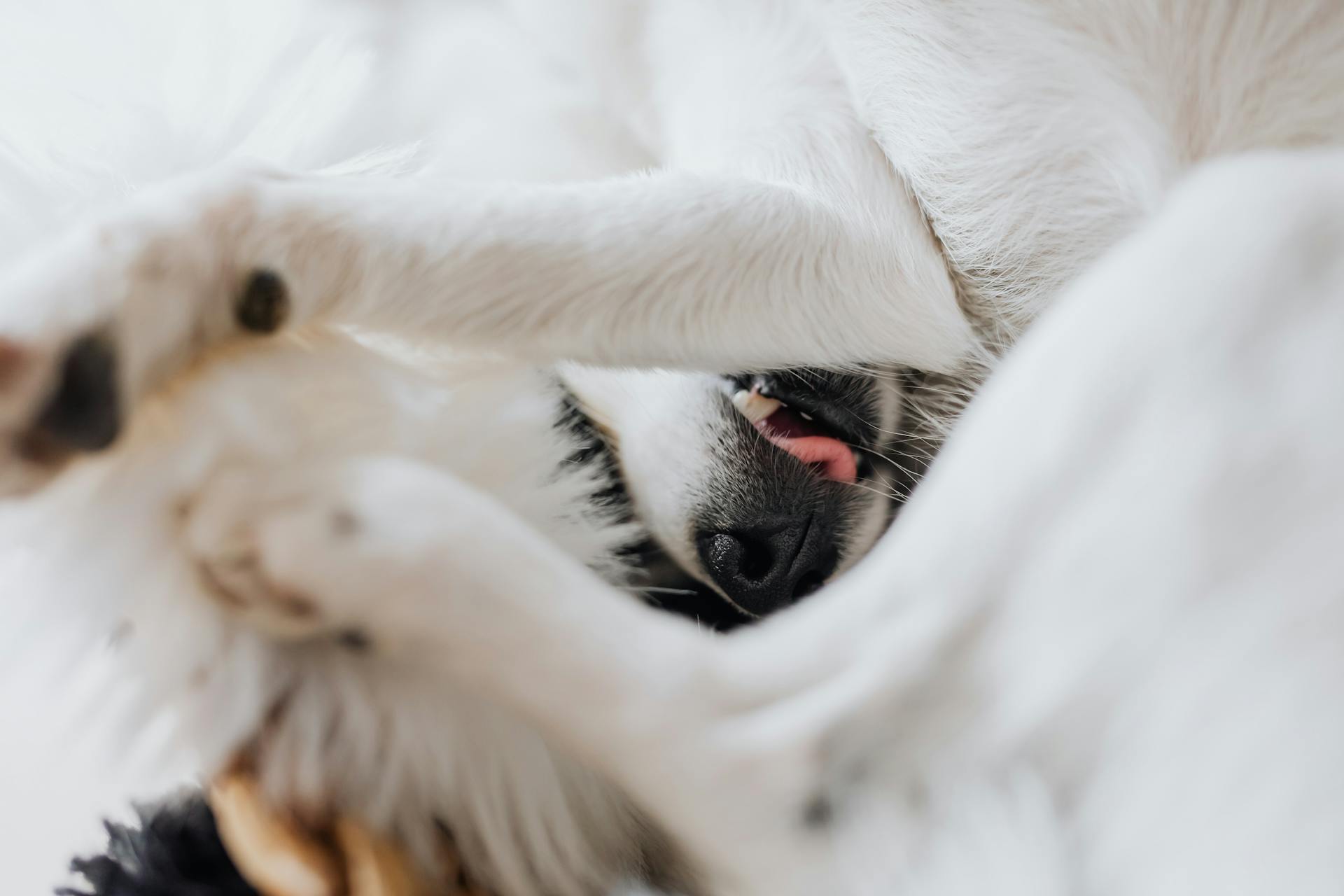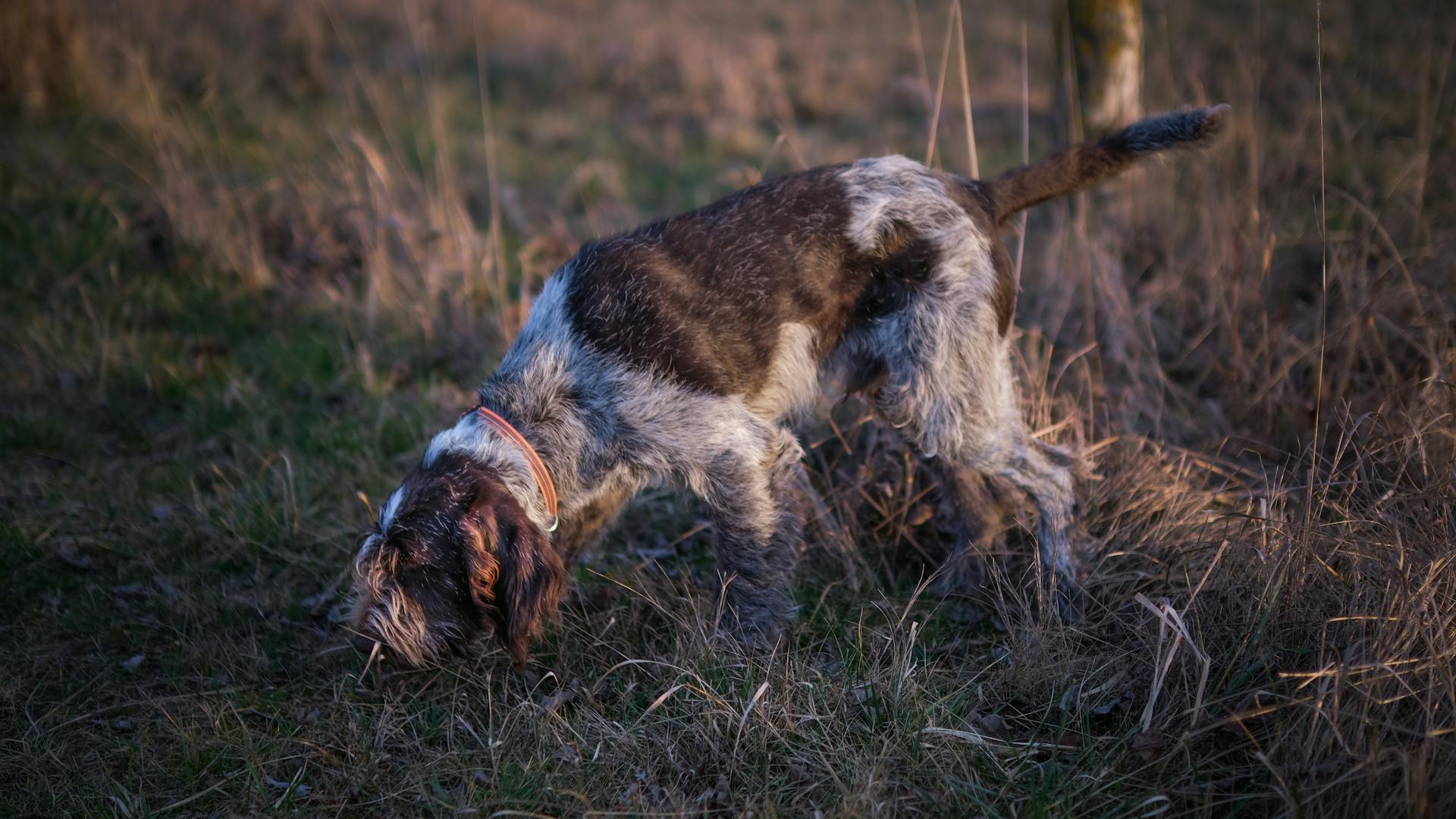
Dog nose work is a fun and rewarding activity that challenges your dog's sense of smell and problem-solving skills. It's also a great way to mentally stimulate your dog and strengthen your bond with them.
Dogs have up to 300 million olfactory receptors in their noses, compared to only 6 million in humans, making them incredibly skilled sniffers. This is why dog nose work is such a great activity for them.
With patience and practice, your dog can learn to detect a wide range of scents, from essential oils to treats. The key is to start with simple exercises and gradually increase the difficulty level as your dog becomes more confident and skilled.
NW270: Foundations
NW270: Foundations is a crucial part of nose work training. It's essential to establish a strong foundation before moving on to more complex exercises.
You'll need a few basic supplies to get started, including cardboard boxes, your dog's favorite treats, and a 6-foot leash. These items will help you create a fun and engaging environment for your dog to learn.
To lay the groundwork, remove your dog from the working area and hide treats in cardboard boxes. This will encourage your dog to use their sense of smell and self-reward. You can start with about six boxes and bait at least half of them with treats.
As you begin training, remember to keep each round short, lasting only a minute or two. You'll want to do at least six sessions before introducing the next challenge. This will give your dog time to learn and build their confidence.
Here are some key things to keep in mind during each training session:
- Offer your dog water between rounds to keep them hydrated.
- Avoid petting your dog while they're searching to prevent distractions.
- Don't give your dog treats directly; instead, let them find the treats on their own.
By following these simple steps and establishing a strong foundation, you'll be well on your way to teaching your dog nose work.
Equipment and Training
To start dog nose work, you'll need some basic equipment like yummy treats or a toy, cardboard boxes, and your dog's leash.
As you progress, you'll need a few essential oils like birch, anise, and clove, and cotton swabs to hold the scent.
Your dog will need to rest in between search exercises, so be prepared to crate her or take her for a car ride to give her a good nap.
At the Nose Work II level, you'll revisit the use of boxes to stimulate your dog's desire to find the target odor and increase drive.
Boxes are a main focal point throughout your dog's nose work journey and will be revisited from time to time.
In Nose Work II, you'll also focus on handling skills, handler strategies, and observation skills within all elements.
Preparing for an ORT (Odor Recognition Test) and starting your dog on their journey towards their NW1 title is also included at this level.
You can choose from various class schedules, including Sundays at 8:00am with Sue Sentowski, Mondays at 4:15pm with Robin Taylor, or Thursdays at 6pm with Sue Sentowski.
Additional reading: How Do You Have a Dog and Work Full Time
Learning and Competing
Dogs as young as 6 months can compete in K9 Nose Work trials. You'll see them competing across the country, with thousands of dogs and their human partners participating.
To compete, you must join the National Association of Canine Scent Work, which regulates the sport and ensures consistency and excellence. The NACSW also certifies all K9 Nose Work trainers.
There are five levels of competition: NW1, NW2, NW3, Elite, and Summit. You'll have to prepare your dog for each level, building on the foundation skills learned in previous classes, like in the Nose Work III class.
Benefits of
You and your dog can enjoy a new way to have fun together with K9 Nose Work. This sport teaches your dog to recognize and search for specific scents and helps you better understand how your dog communicates with you.
The beauty of nose work is that virtually any dog can do it, including dogs who can’t take part in more vigorous exercise because of age or physical limitations. This makes it a great option for many dog owners.
Engaging in nose work helps keep dogs mentally healthy while they’re waiting for homes, and it can even be a marketing tool that helps them get adopted. By participating in nose work, you can bring your relationship with your dog to the next level.
Benefits of dog nose work include physical activity, mental stimulation, and confidence building. For both the dog and the handler, nose work is a great way to bond and have fun together.
Palo Alto Dog Training is proud to be a K9 Nose Work resource for dog lovers throughout the San Francisco Peninsula who want a new way to keep their dogs calmer, mentally stimulated and content.
Pet Competing in K9 Trials
Pet competing in K9 trials is a fun and rewarding experience for dogs and their owners. Thousands of dogs and their human partners compete in K9 Nose Work trials across the country.
Dogs as young as 6 months can compete in K9 Nose Work trials. The initial trials were regulated by the National Association of Canine Scent Work (NACSW), which ensures consistency and high standards for competitors.
Currently, there are five levels of competition: NW1, NW2, NW3, Elite, and Summit. To gain eligibility to compete, dogs must successfully complete an odor recognition test.
Competitors can choose from various associations, including the NACSW, AKC, and USCSS. These organizations offer scenting trials and certification for trainers.
K9 Nose Work is a great way to exercise your dog physically and mentally. It's a new way to have fun together, anytime, anywhere.
III

Nose Work III is a crucial step in preparing your dog for competition. This level is for dog/handler teams preparing for their NW1.
You'll continue to build on the foundation skills learned in Levels 1 and 2, with a stronger emphasis on handling skills, handler strategies, and observation skills. Instructors will also prepare you for what to expect on competition day.
Classes will be held at Urban Pooch Training and Fitness Center or a convenient location in the area. Pre-requisite for this level is that all dogs must have had exposure to all the elements during Level 2 and be ready to compete in an Odor Recognition Test or instructor approval.
You can find upcoming class dates and instructor information by visiting the National Association of Canine Scent Work website.
Puppy and Beginner
Puppies can start learning Nose Work as young as 4 months old.
This age group is perfect for introducing them to the sport, and classes are designed to be fun and engaging for both puppies and owners.
The Puppy Nose Work class is a 6-week program that introduces puppies to Nose Work through a series of fun games.
Each class is 60 minutes long and is geared towards puppies between 4 and 8 months old.
Dogs of all ages can learn scent detection activities without prior behavioral training, making it a great activity for beginners.
Even dogs that are disabled or recovering from an illness or injury can participate and have fun with scent recognition.
Instructors and Resources
Our instructors bring a wealth of knowledge and experience to their classes, having trained their own dogs in various dog sports.
Sue Sentowski, a Certified Nose Work Instructor (CNWI), participates in Nose Work competitions with her dogs, Splash and C.J., both of whom are NW3 level. She knows that positive reinforcement is essential for success in competition and building a strong human-canine relationship.
Robin, another experienced instructor, started her dog training journey 10 years ago and has competed in agility and nose work with her dogs, Dylan, Kaiden, and Raze.
Instructors

Sue Sentowski is a Certified Nose Work Instructor (CNWI) with the National Association of Canine Scent Work (NACSW).
She brings her extensive knowledge and experience to her classes, gained from training her own dogs in dog sports like Agility, Rally, Dock Dive, and Nose Work.
Sue's dogs, Splash and C.J., are both NW3 level and participate in Nose Work competitions with her.
She believes in using positive reinforcement in training, which is essential for building a productive human-canine relationship and succeeding in competition.
Robin is also a dog trainer with a decade of experience, starting with her adopted dog Dylan from the Anti-Cruelty Society.
She has competed in agility and nose work with her dogs and now competes with her newest rescue dog, Kaiden.
Robin emphasizes that all dogs are individuals and need to be treated as such, focusing on clear communication and consistency in her training approach.
Instructors like Sue and Robin work one-on-one with each dog, making their classes suitable even for dogs who are reactive toward other dogs.
You can find certified nose work instructors and workshops in your area through the National Association of Canine Scent Work website.
Here's an interesting read: Crate Training a Dog While at Work
Helpful AI assistant

As a helpful AI assistant, I've noticed that effective communication is key in Nose Work, especially at the NW3 level where teams are working towards their Elite titles. Good communication between you and your dog is essential.
Team work is crucial at this level, and handlers need to be able to think quickly on their feet to succeed. This is where practice and experience come into play.
To prepare for the Elite level, building longer endurance times is important, as some searches could be up to 5 – 6 + minutes. This requires a well-conditioned dog and handler team.
At the Elite level, you'll encounter real-life searches with no set rules, and areas can be either extremely small or extremely large. This requires adaptability and quick thinking.
To qualify for the Elite level, all dogs must have earned at least one NW3 title or receive instructor approval.
Frequently Asked Questions
How does a dog's nose work?
Dogs' noses work by inhaling odor molecules that dissolve in mucus, which are then picked up by olfactory receptors behind the nose. This highly sensitive system allows dogs to detect scents with remarkable accuracy.
Does nose work tire dogs out?
Yes, nose work can tire dogs out surprisingly well, despite being a low-impact activity, as it engages both their mind and body. A 20-30 minute nose work session can be a great addition to your dog's exercise routine.
What is the difference between AKC and Nacsw nosework?
AKC Scent Work and NACSW nosework share a common goal, but differ in their search methods, with AKC including a buried element and handler discrimination, while NACSW involves vehicle searches
Featured Images: pexels.com


